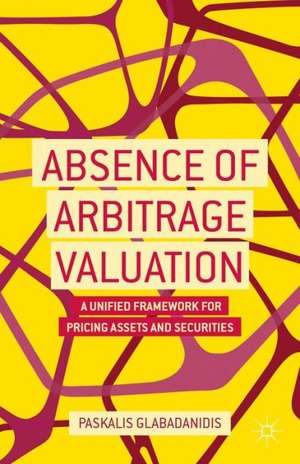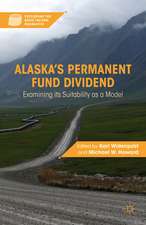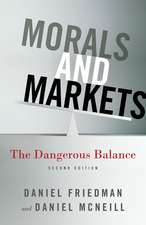Absence of Arbitrage Valuation: A Unified Framework for Pricing Assets and Securities
Autor P. Glabadanidisen Limba Engleză Hardback – 10 iul 2014
| Toate formatele și edițiile | Preț | Express |
|---|---|---|
| Paperback (1) | 378.71 lei 6-8 săpt. | |
| Palgrave Macmillan US – 10 iul 2014 | 378.71 lei 6-8 săpt. | |
| Hardback (1) | 383.93 lei 6-8 săpt. | |
| Palgrave Macmillan US – 10 iul 2014 | 383.93 lei 6-8 săpt. |
Preț: 383.93 lei
Nou
Puncte Express: 576
Preț estimativ în valută:
73.46€ • 76.91$ • 60.79£
73.46€ • 76.91$ • 60.79£
Carte tipărită la comandă
Livrare economică 05-19 aprilie
Preluare comenzi: 021 569.72.76
Specificații
ISBN-13: 9781137373021
ISBN-10: 1137373024
Pagini: 148
Ilustrații: XIII, 148 p.
Dimensiuni: 140 x 216 x 15 mm
Greutate: 0.32 kg
Ediția:2014
Editura: Palgrave Macmillan US
Colecția Palgrave Macmillan
Locul publicării:New York, United States
ISBN-10: 1137373024
Pagini: 148
Ilustrații: XIII, 148 p.
Dimensiuni: 140 x 216 x 15 mm
Greutate: 0.32 kg
Ediția:2014
Editura: Palgrave Macmillan US
Colecția Palgrave Macmillan
Locul publicării:New York, United States
Cuprins
1. Asset Pricing Models 12 1.1. Future Value 1.2. Present Value 1.3. Perpetuities 1.4. Annuities 1.5. Capital Asset Pricing Model 1.5.1. The Case of Two Risky Securities 1.5.2. The Case of Multiple Risky Securities 1.6. Fama-French Three-Factor Model 1.7. Carhart Four-Factor Model 1.8. Arbitrage Pricing Theory 1.9. Macroeconomic Multi-Factor Models 2. Discounted Cash Flow Valuation 2.1. Dividend Growth Models 2.1.1. Single-Stage Models 2.1.2. Two-Stage Models 2.1.3. Three-Stage Models 2.2. Equity Free Cash Flow 2.2.1. Single-Stage FCFE Model 2.2.2. Two-Stage FCFE Model 2.2.3. Three-Stage FCFE Model 2.3. Firm Free Cash Flow 2.3.1. Single-Stage FCFF Mode 2.3.2. Two-Stage FCFF Model 2.3.3. Three-Stage FCFF Model 3. Relative Valuation with Equity and Value Multiples 3.1. Equity Multiples 3.1.1. Price-Dividend Ratio 3.1.2. Price-Earnings Ratio 3.1.3. Price-to-Book Ratio 3.1.4. Price-Sales Ratio 3.2. Value Multiples 3.2.1. Value-to-Income Ratio 3.2.2. Value-to-Book Ratio 3.2.3. Value-to-Sales Ratio 4. Financial Options 4.1. Equity Calls and Puts 4.2. Examples of Option Strategies 4.2.1. A Protective Put Strategy 4.2.2. A Straddle Example 4.2.3. A Butterfly Example 4.3. Option Valuation 4.3.1. Bounds on Option Values 4.4. Option Pricing 5. Real Options 5.1. Equity and Bond Pricing as Options on Asset 5.2. Pricing Convertible Bonds 5.3. Option to Wait 5.4. Option to Abandon 6. Fixed Income Securities 6.1. Bond Characteristics 6.2. Bond Pricing 6.2.1. Basics 6.2.2. Bond Pricing Example 6.2.3. Bond Prices at Different Times to Maturity and YTM 6.2.4. Bond Yields 6.2.5. Bond Yields on Callable Bonds 6.2.6. Credit Risk 6.3. Spot and Forward Interest Rates 6.3.1. The Yield Curve 6.4. Term Structure of Interest Rates 6.4.1. Expectations Hypothesis 6.4.2. Liquidity Preference 6.4.3. Market Segmentation 6.4.4. Preferred Habitat Theories 6.4.5. Interpreting the Term Structure 6.4.6. Measuring the Term Structure 6.4.7. More Bonds than Time Periods 6.5. Fixed Income Arbitrage Strategies 6.6. Duration 6.7. Convexity 6.8. Bond Portfolios 7. Fixed Income Derivatives 7.1. Interest Rate Models 7.1.1. Traditional Term Structure Models 7.1.2. Term Structure Consistent Models 7.2. Binomial Term Structure Models 7.2.1. Pricing a Fixed Coupon Risk-Free Bond 7.2.2. Pricing a Risk-Free Floating-Rate Note (FRN) 7.2.3. An Interest Rate Swap 7.2.4. Adjustable-Rate Mortgages (ARM) 7.2.5. Pricing an Interest Rate Cap/Caption 7.2.6. Pricing an Interest Rate Floor/Flotion 7.2.7. Pricing a Reverse Floater 8. Foreign Exchange 8.1. Spot and Forward Commodity Prices 8.1.1. Purchasing Power Parity 8.2. Spot and Forward Exchange Rates 8.2.1. Triangular Arbitrage with Bid-ask Spread 8.2.2. Interest Rate Parity 8.3. Foreign Exchange Capital Budgeting 8.4. Currency Option Valuation 8.5. Currency Option Put-Call Parity 8.6. Pricing Currency Futures Options 8.7. Currency Futures Option Put-Call Parity 9. What Next? 9.1. Contingent Convertible Securities 9.2. Longevity Swaps 9.3. Acts of God versus Acts of Man Index
Recenzii
"Absence of Arbitrage Valuation provides a simple yet comprehensive approach to asset pricing and valuation based on absence of arbitrage arguments. The text starts out by presenting the most basic valuation and asset pricing models and progresses to discussing more complicated financial instruments and real investment projects. The book will be of much use to practitioners as well as students and academics who seek a carefully explained yet hands-on approach to valuation."
-Sumru Altug, Koc University and CEPR, author of Asset Pricing for Dynamic Economies (2008)
-Sumru Altug, Koc University and CEPR, author of Asset Pricing for Dynamic Economies (2008)
Notă biografică
Paskalis Glabadanidis is Senior Lecturer in Finance at the University of Adelaide.










